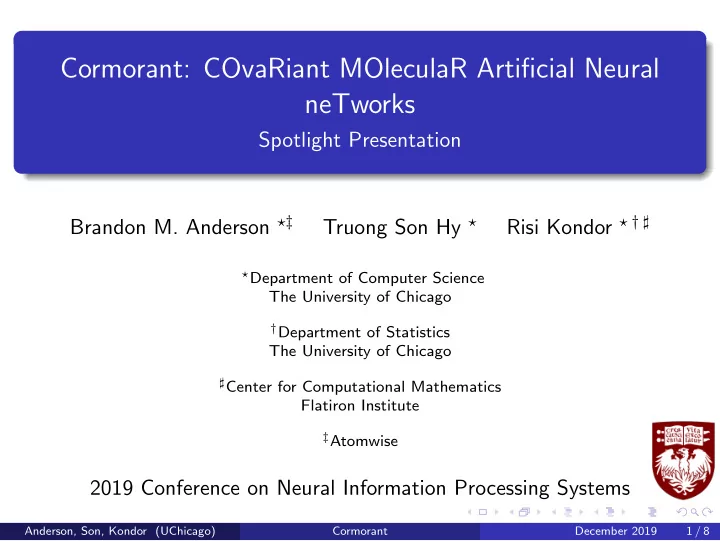

Cormorant: COvaRiant MOleculaR Artificial Neural neTworks Spotlight Presentation Brandon M. Anderson ⋆ ‡ Risi Kondor ⋆ † ♯ Truong Son Hy ⋆ ⋆ Department of Computer Science The University of Chicago † Department of Statistics The University of Chicago ♯ Center for Computational Mathematics Flatiron Institute ‡ Atomwise 2019 Conference on Neural Information Processing Systems Anderson, Son, Kondor (UChicago) Cormorant December 2019 1 / 8
Learning on molecular data Learn on molecules: Data has built-in symmetry → Use covariant activations! Anderson, Son, Kondor (UChicago) Cormorant December 2019 2 / 8
The multipole expansion r ) / r 3 + . . . Q 0 Y 0 (ˆ Q 1 Y 1 (ˆ r ) / r 2 + Q 2 Y 2 (ˆ � i Z i / | r − r i | = r ) / r + monopole dipole quadrupole Q ℓ : ℓ -th multipole moment Y ℓ : ℓ -th spherical harmonic Anderson, Son, Kondor (UChicago) Cormorant December 2019 3 / 8
Covariant rotations Consider a 90 ◦ CCW-rotation R : Anderson, Son, Kondor (UChicago) Cormorant December 2019 4 / 8
Covariant rotations Consider a 90 ◦ CCW-rotation R : After a rotation: Anderson, Son, Kondor (UChicago) Cormorant December 2019 4 / 8
Covariant rotations Consider a 90 ◦ CCW-rotation R : After a rotation: All moments rotate “covariantly”: Q ℓ → D ℓ ( R ) Q ℓ Anderson, Son, Kondor (UChicago) Cormorant December 2019 4 / 8
Clebsch-Gordan Transformation Group theory: ℓ 1 + ℓ 2 � � D ℓ 1 ( R ) ⊗ D ℓ 2 ( R ) = C † � D ℓ ( R ) C ℓ 1 ,ℓ 2 ℓ 1 ,ℓ 2 ℓ = | ℓ 1 − ℓ 2 | D ℓ ( R ): Wigner-D (Rotation) matrix C ℓ 1 ℓ 2 : Clebsch-Gordan matrix R ∈ SO ( 3 ) Anderson, Son, Kondor (UChicago) Cormorant December 2019 5 / 8
SO ( 3 )-Vectors SO ( 3 )-Vector: F ℓ, c Transforms covariantly: F ℓ, c → D ℓ ( R ) F ℓ, c Anderson, Son, Kondor (UChicago) Cormorant December 2019 6 / 8
SO ( 3 )-Vectors SO ( 3 )-Vector: F ℓ, c Transforms covariantly: F ℓ, c → D ℓ ( R ) F ℓ, c Limited operations available: Linearly mixed: � c F ℓ, c ′ W c ′ c Anderson, Son, Kondor (UChicago) Cormorant December 2019 6 / 8
SO ( 3 )-Vectors SO ( 3 )-Vector: F ℓ, c Transforms covariantly: F ℓ, c → D ℓ ( R ) F ℓ, c Limited operations available: Linearly mixed: � c F ℓ, c ′ W c ′ c � � ℓ 1 + ℓ 2 � Clebsch-Gordan product: F ℓ 1 , c ⊗ CG F ℓ 2 , c = C ℓ 1 ℓ 2 ℓ = | ℓ 1 − ℓ 2 | F ℓ, c Anderson, Son, Kondor (UChicago) Cormorant December 2019 6 / 8
SO ( 3 )-Vectors SO ( 3 )-Vector: F ℓ, c Transforms covariantly: F ℓ, c → D ℓ ( R ) F ℓ, c Limited operations available: Linearly mixed: � c F ℓ, c ′ W c ′ c � � ℓ 1 + ℓ 2 � Clebsch-Gordan product: F ℓ 1 , c ⊗ CG F ℓ 2 , c = C ℓ 1 ℓ 2 ℓ = | ℓ 1 − ℓ 2 | F ℓ, c m | [ F ℓ ] m | 2 Construct scalars: � Anderson, Son, Kondor (UChicago) Cormorant December 2019 6 / 8
Aggregation Clebsch-Gordan aggregation: � F i = E ij ⊗ CG F j i ∈ N ( j ) → Ensures covariance! Anderson, Son, Kondor (UChicago) Cormorant December 2019 7 / 8
Experiments Table 1. GDB-9 results Table 2. MD-17 results Cormorant SchNet [3] NMP [4] WaveScatt [5] Cormorant DeepMD [6] DTNN [7] SchNet [3] GDML [2] sGDML [8] α ( bohr 3 ) Aspirin 0.098 0.201 – 0.120 0.270 0.190 0.085 0.235 0.092 0.160 Benzene 0.023 0.065 0.040 0.070 0.070 0.100 ∆ ǫ (eV) 0.061 0.063 0.069 0.118 Ethanol 0.027 0.055 – 0.050 0.150 0.070 Malonaldehyde 0.041 0.092 0.190 0.080 0.160 0.100 ǫ HOMO (eV) 0.034 0.041 0.043 0.085 Naphthalene 0.029 0.095 – 0.110 0.120 0.120 ǫ LUMO (eV) 0.038 0.034 0.038 0.076 Salicylic Acid 0.066 0.106 0.410 0.100 0.120 0.120 µ (D) 0.038 0.033 0.030 0.340 Toluene 0.034 0.085 0.180 0.090 0.120 0.100 C v (cal/mol K) 0.026 0.033 0.040 0.049 Uracil 0.023 0.085 – 0.100 0.110 0.110 G (eV) 0.020 0.014 0.019 0.022 H (eV) 0.021 0.014 0.017 0.022 R 2 ( bohr 2 ) 0.961 0.073 0.180 0.410 U (eV) 0.021 0.019 0.020 0.022 U 0 (eV) 0.022 0.014 0.020 0.022 ZPVE (meV) 2.027 1.700 1.500 2.000 [1] R. Ramakrishnan, P. O. Dral, M. Rupp, and O A. von Lilienfeld. Scientific Data, 1, 140022 (2014). [2] S. Chmiela, A. Tkatchenko, H. E. Sauceda, I. Poltavsky, K. T. Sch¨ utt, and K.-R. M¨ uller. Sci. Adv. 3, e1603015 (2017) [3] K. T. Sch¨ utt, H. E. Sauceda, P.-J. Kindermans, A. Tkatchenko, and K.-R. M¨ uller. J. Chem. Phys. 148, 241722 (2018) [4] J. Gilmer, S. S. Schoenholz, P. F. Riley, O. Vinyals, and H. E. Dahl. PMLR 70, 1263, (2017). [5] M. Hirn, S. Mallat, and N. Poilvert. Multiscale Modeling Simulation, 15, 827 (2017). [6] L. Zhang, J. Han, H. Wang, R. Car, and W. E. Phys. Rev. Lett., 120, 143001 (2018). [7] K. T. Sch¨ utt, F. Arbabzadah, S. Chmiela, K.-R. Muller, and A. Tkatchenko. Nat. Comm. 8, 13890 (2017). [8] S. Chmiela, H. E. Sauceda, K.-R. Muller, and A. Tkatchenko. Nat. Comm., 9, 3887 (2018). Anderson, Son, Kondor (UChicago) Cormorant December 2019 8 / 8
Recommend
More recommend